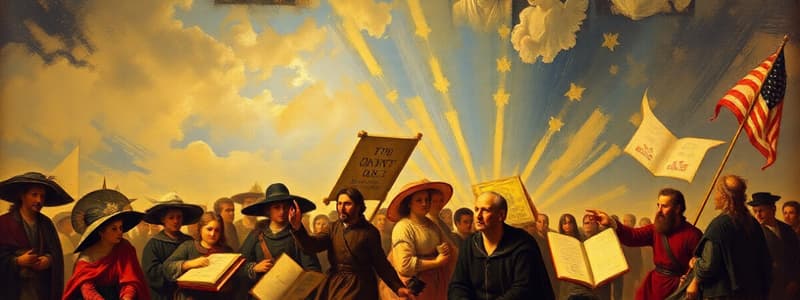Podcast
Questions and Answers
Why did many colonists come to America?
Why did many colonists come to America?
- To escape religious persecution and seek religious freedom. (correct)
- To discover new scientific advancements and intellectual opportunities.
- To expand their political influence and control new territories.
- To establish new trade routes and amass wealth.
According to the content, religious freedom is a straightforward and universally agreed-upon concept.
According to the content, religious freedom is a straightforward and universally agreed-upon concept.
False (B)
What event in Santa Fe, Texas, highlighted the debate over religious freedom?
What event in Santa Fe, Texas, highlighted the debate over religious freedom?
A student-led prayer at a high school football game.
The right to freedom of religion is listed in the ______ of Rights.
The right to freedom of religion is listed in the ______ of Rights.
Match the individuals with their stance on the Santa Fe prayer controversy:
Match the individuals with their stance on the Santa Fe prayer controversy:
What was the Supreme Court's decision regarding public prayer at football games?
What was the Supreme Court's decision regarding public prayer at football games?
The First Amendment solely protects the right to practice religion but does not address the freedom to not worship at all.
The First Amendment solely protects the right to practice religion but does not address the freedom to not worship at all.
According to Amanda Bruce, what should people consider when expressing their religious beliefs in public settings?
According to Amanda Bruce, what should people consider when expressing their religious beliefs in public settings?
The struggle to define and protect religious freedom continues ______.
The struggle to define and protect religious freedom continues ______.
Which of the following best describes the central conflict surrounding religious freedom, as illustrated by the Santa Fe case?
Which of the following best describes the central conflict surrounding religious freedom, as illustrated by the Santa Fe case?
Which of the following best describes the initial attitude of many American colonies towards religious freedom?
Which of the following best describes the initial attitude of many American colonies towards religious freedom?
The Virginia Statute for Religious Freedom, drafted by Thomas Jefferson, faced no opposition during its passage through the Virginia Assembly.
The Virginia Statute for Religious Freedom, drafted by Thomas Jefferson, faced no opposition during its passage through the Virginia Assembly.
According to Thomas Jefferson, what role should the government play in religious matters?
According to Thomas Jefferson, what role should the government play in religious matters?
The First Amendment states, 'Congress shall make no law respecting an establishment of religion, or prohibiting the free ______ thereof.'
The First Amendment states, 'Congress shall make no law respecting an establishment of religion, or prohibiting the free ______ thereof.'
Match the following Supreme Court cases with their main issue:
Match the following Supreme Court cases with their main issue:
What is the significance of the Fourteenth Amendment in the context of religious freedom?
What is the significance of the Fourteenth Amendment in the context of religious freedom?
The Supreme Court's interpretation of the Establishment Clause has remained consistent and unchallenged since the Bill of Rights was written.
The Supreme Court's interpretation of the Establishment Clause has remained consistent and unchallenged since the Bill of Rights was written.
Besides Thomas Jefferson, which other figure played a significant role in advocating for religious liberty and the inclusion of a religious freedom clause in the Bill of Rights?
Besides Thomas Jefferson, which other figure played a significant role in advocating for religious liberty and the inclusion of a religious freedom clause in the Bill of Rights?
Jefferson described the First Amendment as building 'a wall of ______ between church and state'.
Jefferson described the First Amendment as building 'a wall of ______ between church and state'.
In recent years, what trend has been observed in the Supreme Court's rulings regarding religious freedom?
In recent years, what trend has been observed in the Supreme Court's rulings regarding religious freedom?
Flashcards
Religious Freedom
Religious Freedom
The right to worship (or not) without interference.
Religious Freedom's Place
Religious Freedom's Place
First right listed in the Bill of Rights.
Marian Ward
Marian Ward
A student who delivered a prayer at a football game despite a court ruling.
Amanda Bruce
Amanda Bruce
Signup and view all the flashcards
Court Ruling in Santa Fe
Court Ruling in Santa Fe
Signup and view all the flashcards
Supreme Court Decision
Supreme Court Decision
Signup and view all the flashcards
Differing Views on Religious Freedom
Differing Views on Religious Freedom
Signup and view all the flashcards
Colonists' Motivation
Colonists' Motivation
Signup and view all the flashcards
Bill of Rights
Bill of Rights
Signup and view all the flashcards
Religious Persecution
Religious Persecution
Signup and view all the flashcards
Separation of Church and State
Separation of Church and State
Signup and view all the flashcards
Virginia Statute for Religious Freedom
Virginia Statute for Religious Freedom
Signup and view all the flashcards
Religion Clause of the First Amendment
Religion Clause of the First Amendment
Signup and view all the flashcards
Fourteenth Amendment's Impact on Religious Freedom
Fourteenth Amendment's Impact on Religious Freedom
Signup and view all the flashcards
Everson v. Board of Education (1947)
Everson v. Board of Education (1947)
Signup and view all the flashcards
Engel v. Vitale (1962)
Engel v. Vitale (1962)
Signup and view all the flashcards
Lee v. Weisman (1992)
Lee v. Weisman (1992)
Signup and view all the flashcards
Santa Fe Independent School District v. Doe (2000)
Santa Fe Independent School District v. Doe (2000)
Signup and view all the flashcards
Town of Greece, NY v. Galloway (2014)
Town of Greece, NY v. Galloway (2014)
Signup and view all the flashcards
Burwell v. Hobby Lobby (2014)
Burwell v. Hobby Lobby (2014)
Signup and view all the flashcards
Study Notes
- Religious freedom is the foremost right mentioned in the Bill of Rights.
- It remains a contentious topic with ongoing debates regarding its definition and protection.
Santa Fe Prayer Incident
- In Santa Fe, Texas, student Marian Ward recited a prayer over the loudspeaker at a high school football game, defying a court ruling against public prayer on school grounds.
- Fellow student Amanda Bruce protested, asserting the prayer could offend those of different faiths.
- Bruce helped organize a protest with signs reading "Prayer is Private."
- The Supreme Court later declared the practice of public prayer at football games unconstitutional.
Defining Religious Freedom
- Religious freedom is the right to worship as one chooses, or not at all, without interference.
- The definition and protection of this right are interpreted differently by different people.
Religious Liberty in the Colonies
- Colonists sought religious freedom in America but often didn't extend it to others.
- Most colonies established a government-sponsored church and penalized those practicing different faiths through punishments like fines, imprisonment, whipping, or even death.
- Increased religious diversity and Enlightenment beliefs gradually led to changes.
- Thinkers like Thomas Jefferson and James Madison advocated for equality, arguing that no religion should be favored to ensure equal rights for all.
Jefferson's Law
- Jefferson believed in the separation of church and state, advocating that government should neither support nor oppose any religion.
- In 1776, Jefferson began advocating for religious reform in the Virginia Assembly.
- As governor in 1779, he proposed a bill to make religious freedom the law in Virginia.
- The Virginia Statute for Religious Freedom, enacted in 1786, prohibited mandatory attendance or support of any religious institution and ensured freedom of religious expression.
- Jefferson considered this law one of his most important achievements as it formed the basis for religious freedom in the First Amendment.
The Religion Clause of the First Amendment
- James Madison included a clause on religious freedom in his proposal for the Bill of Rights.
- The final version of the religion clause in the First Amendment states: "Congress shall make no law respecting an establishment of religion, or prohibiting the free exercise thereof."
- The clause only explicitly mentions Congress, leaving ambiguity regarding its application to the states.
- The phrase "an establishment of religion" is interpreted differently, with some believing it prevents the creation of an official religion and others arguing it prohibits all government involvement in religion, citing Jefferson's "wall of separation between church and state."
The Issue Moves to the Courts
- For 150 years following the Bill of Rights, there was little debate over religious freedom.
- In the 1940s, the Supreme Court began hearing cases involving potential violations of religious freedom at the state level, based on the Fourteenth Amendment.
- The Fourteenth Amendment, ratified in 1868, guarantees equal protection of the laws to all individuals, extending First Amendment rights, including religious freedom, to the states.
- In Everson v. Board of Education (1947), the Court ruled that public funds cannot be used for religious activities, but tax money can be used for basic services like bus transport for students attending Catholic schools.
School Prayer Cases
- Engel v. Vitale (1962): The Court struck down official prayer in New York public schools.
- Lee v. Weisman (1992): The Court banned school-sponsored prayer at graduation ceremonies.
- Santa Fe Independent School District v. Doe (2000): The Court prohibited schools from sponsoring prayer before football games.
- These decisions sparked protests, with some arguing that the Court was violating their religious freedom by prohibiting prayer and other religious activities.
Recent Rulings
- Town of Greece, NY v. Galloway (2014): The Court upheld the practice of opening town meetings with a prayer.
- Burwell v. Hobby Lobby (2014): The Court ruled that family-owned businesses can make certain business decisions based on religious beliefs.
- Ensuring religious freedom for all remains an ongoing challenge, with disputes that are not easily resolved.
Studying That Suits You
Use AI to generate personalized quizzes and flashcards to suit your learning preferences.
Description
An overview of religious freedom as the foremost right mentioned in the Bill of Rights. Includes the Santa Fe Prayer Incident. Also defines religious liberty in the colonies.




